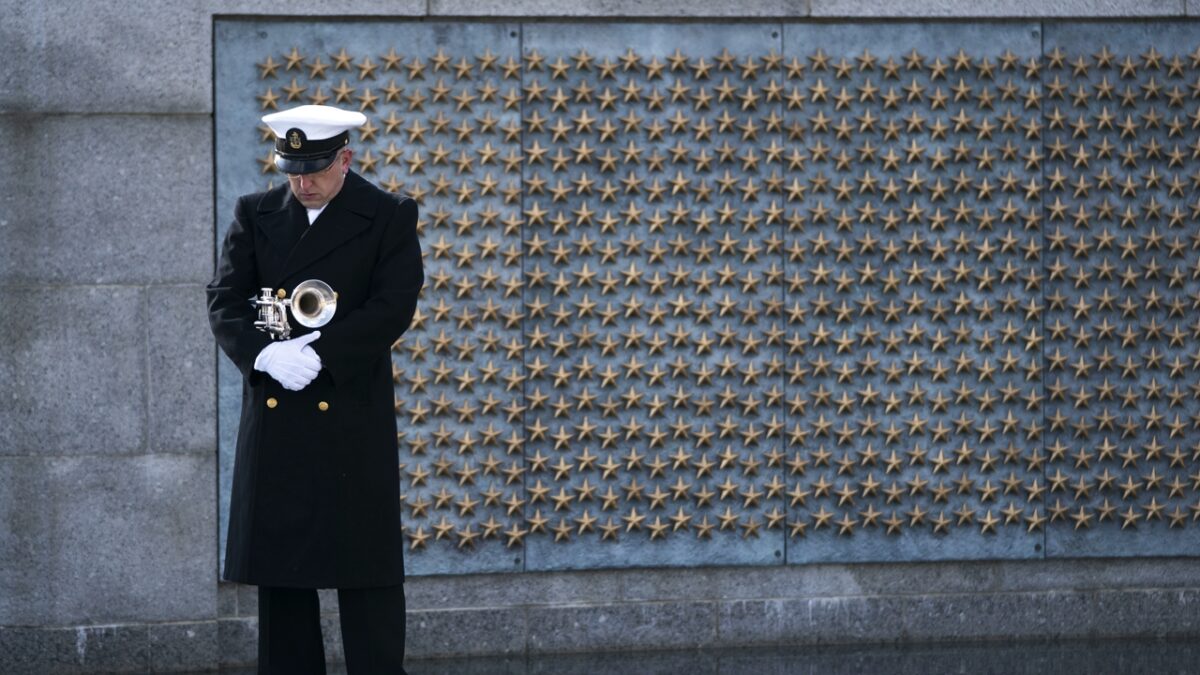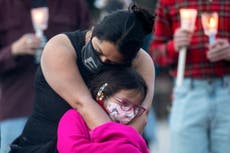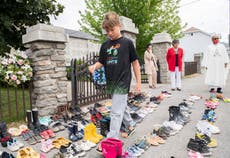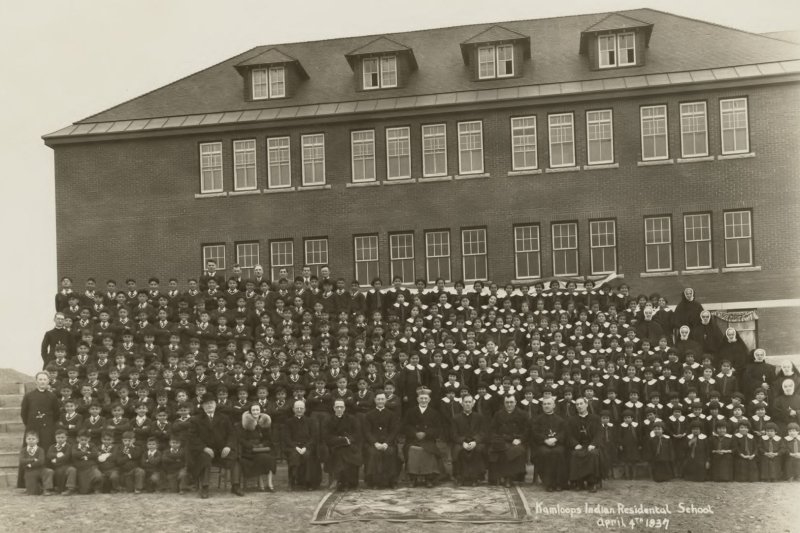US Freedom Riders remember summer of change 60 years later
From May to November of 1961 more than 400 young activists, Black and white, boarded interstate buses headed for cities.

An unidentified white man sitting in front of a Greyhound bus to prevent it from leaving the station with load of Freedom Riders testing bus station segregation in the South, on May 15, 1961, in Anniston, Alabama [File: AP Photo]
AL JAZEERA
31 May 2021
Sixty years ago, a group of idealistic young people set out to challenge segregation in the southern United States. Among them were Lewis Zuchman, 19, and Luvaghn Brown, 16, who became friends during the Freedom Rides campaign in the summer of 1961. Now in their 70s, neither is sure of the details.
“I was the youngest white freedom rider, and Luvaghn was the youngest Black freedom rider,” Zuchman told Al Jazeera. “We met somehow.”
Brown said the pair met in Jackson, Mississippi but how they got to talking – “we can’t figure that out,” he laughed.

Luvaghn Brown, now in his 70s, was at the age of 16 the youngest Black freedom rider in 1961 [Simon Tate/Al Jazeera]
From May to November of that year, more than 400 young activists – Black and white – boarded interstate buses headed for cities in the US South. Their mission: to challenge the segregation that was still being enforced in Southern transit stations despite the Supreme Court ruling the previous year that the practice was unconstitutional.
The reception they received was hostile. The Freedom Riders, as they became known, were often met with fury by Southern whites. There were numerous incidents of mob violence in Alabama and Mississippi, often aided by local police forces. Even if they were lucky enough to avoid a beating, many activists spent weeks in prison.
Zuchman remembers that hatred vividly after his arrest shortly after arriving in Jackson, Mississippi.
“I remember I was shackled, walking along with other prisoners, and the judge, who had sentenced me, saw me and spat on me. The judge!” Zuchman said. “So you began to realise how frightening it was down there. This was not any America that we thought of.”
He spent 40 days at the notorious Parchman State Penitentiary in Mississippi.
“I remember the guy who would give out the food in the morning, who was a big white trustee with tattoos. And one day he said, ‘If it was up to me, I’d poison every one of you MFs.’ And trust me, for the next few days, we were very uptight about eating,” Zuchman added.
He was a long way from his hometown of New York City. Zuchman had been inspired to join the movement by his longtime baseball hero, Jackie Robinson, the first Black man to play Major League Baseball. He saw Robinson on a TV show discussing the Freedom Rides and whether the campaign should end because of the violence.
“At the end of the show, (Robinson) said, with a tear coming down his face, ‘Look, if these young people feel this is the time for them to stand up, who are we to tell them not to?’ So I decided to volunteer to be a Freedom Rider the next day.”

Many of those who participated in the Freedom Rides were arrested and spent time in jail
‘Determined to put their lives on the line’
The young people who volunteered for the Freedom Rides were incredibly brave, according to Raymond Arsenault, Emeritus Professor of Southern History at the University of South Florida and author of the book, Freedom Riders: 1961 And The Struggle for Racial Justice.
“Essentially, they were daring the Ku Klux Klan and other white supremacists in the South to stop them,” Arsenault told Al Jazeera, ”They were determined to put their lives on the line, to sit where they were not supposed to sit on the bus and go to the wrong restrooms, sit at the wrong lunch counters in the terminals and force a confrontation.”
The campaign also forced the administration of then-President John F Kennedy to examine racism in the US at a time when it was more concerned about Cold War missiles than Mississippi.

A Freedom Rider bus went up in flames in May 1961 when a firebomb was tossed through a window near Anniston, Alabama. The bus, which was testing bus station segregation in the south, had stopped because of a flat tyre. Passengers escaped without serious injury [File: AP Photo]
When he first heard about the early Freedom Rides, 16-year-old Brown was not interested.
“A lot of them were talking about non-violence and all this stuff. That didn’t appeal to me, quite frankly,” Brown told Al Jazeera, “I felt that in order to change things, you had to hurt people. That’s who I was then.”
Growing up Black in Jackson had made Brown an angry young man. He remembers how Emmett Till’s 1955 murder just up the road in Money when he was 10 years old had sent fear through his community, along with the realisation that “whites could kill anybody they wanted to and get away with it.”
Till, 14 and Black, was beaten and murdered by white men who thought he had spoken inappropriately to a white woman.
But as more rides came into Jackson, Brown began to change his mind.
“I thought it was just marvellous that people would come from all over,” he said. “They explained what the freedom rides were. I said that was cool. We should be doing something.”
Although Brown didn’t ride on the buses, he became very much part of the campaign in Jackson; defying segregation, organising boycotts, spending time in jail and finding himself in what he called scary situations.
“The Klan came after us one night with the help of the local police. And so we escaped by jumping off the roof of a building next to us,” Brown remembers. “The Klan came up the stairs, they were at the front door. We almost got killed.”
A white police officer standing beside a “white waiting room” sign posted outside the Greyhound bus terminal in McComb, Mississippi on November 2, 1961 [File: AP Photo]
‘I never thought we should quit’
Zuchman and Brown hung out a lot in Jackson that summer. And despite the enormous intimidation and the initially indifferent American public opinion, the two were determined to carry on.
“Did I think we’d make a difference? I didn’t know one way or the other,” said Zuchman, “But this was in my blood. I wouldn’t let people treat me that way.”
“I always thought we were right. And I thought we could change things by appealing to the conscience of America,” Brown said. “I never thought we should quit.”
Despite the risks, the Freedom Rides kept coming and eventually, public opinion started to turn. And as news of their mistreatment spread, it forced the Kennedy administration’s hand, according to Arsenault.
“Kennedy was going to his first summit meeting in Vienna with Nikita Khrushchev and he was getting embarrassed all over the front pages of the newspapers about this,” Arsenault said. “People who can’t even sit at the front of the bus, in the so-called land of freedom.”
The US federal government finally acted to ban segregation on the interstate bus network in November 1961, and Kennedy’s adoption of civil rights causes moved beyond the realpolitik of the Cold War.
“There’s no way in the world that John Kennedy ever would have gotten to the point in June of 1963 that he did, advocating for a full-scale, civil rights bill without the Freedom Riders,” said Arsenault
.
Lewis Zuchman, 79, still works to improve the lives of communities of colour [Simon Tate/Al Jazeera]
‘Attitude has a lot to do with what changes’
As for Zuchman and Brown, they still share their experiences, appearing together at events in prisons and schools, and before a new generation grappling with its own civil rights issues. So what advice do they have for today’s activists?
Brown, 76, recognises the desire of some young activists to use some of the more radical methods from his own youth, but these days, he urges a gentler approach.
“It could be as simple as putting your arm around somebody. That can be a revolutionary act, depending on where you are, depending on what they’re doing to that person,” Brown said. “So we try to make young people understand that attitude has a lot to do with what changes.”
At 79, Zuchman still works to improve the lives of communities of colour, as the executive director of Scan Harbor, a non-profit that supports disadvantaged children in New York. But he is reluctant to overstate the success of the Freedom Rides.

Martin Luther King Jr shaking hands with Paul Dietrich just before a bus of Freedom Riders left Montgomery, Alabama on May 24, 1961 [File: AP Photo]
“At our 50th anniversary, people would say to me, ‘Aren’t you proud of what was achieved?’ And I said, ‘No.’ We had some cosmetic success. But I’ve worked in the inner city ever since and I’ve only seen things get worse and worse for African American and Latino young people,” he explained.
But he does concede one victory: “I think the one special thing is it brought together young people – white, African American, male, female – throughout America. It was a unique moment where we came together as a country.”
Arsenault, however, says the effect of the Freedom Rides was enormous.
“It not only revolutionised the civil rights movement, but it changed the whole tenor of citizen politics in the sixties,” he said, “The Freedom Rides really become the template for all the other rights movements.”
SOURCE: AL JAZEERA
 PHOTO VIA CARNIVALGov. Ron DeSantis isn’t wavering from his anti-vaccination “passport” stance as a cruise line has received federal approval to set sail from a Florida port next month, if passengers and crew members are vaccinated against COVID-19.
PHOTO VIA CARNIVALGov. Ron DeSantis isn’t wavering from his anti-vaccination “passport” stance as a cruise line has received federal approval to set sail from a Florida port next month, if passengers and crew members are vaccinated against COVID-19.


















